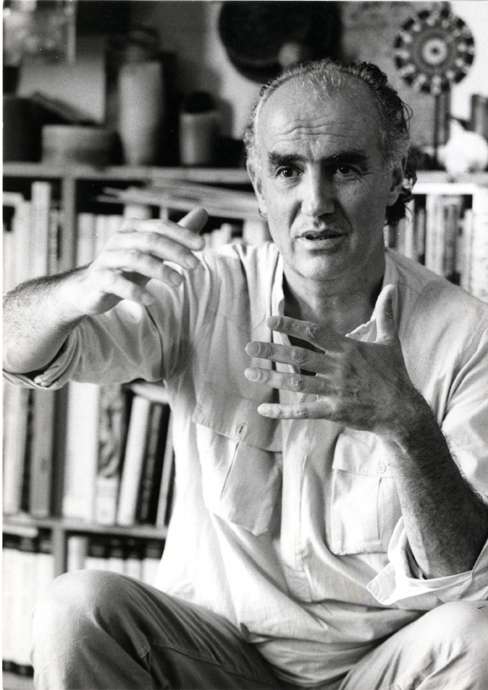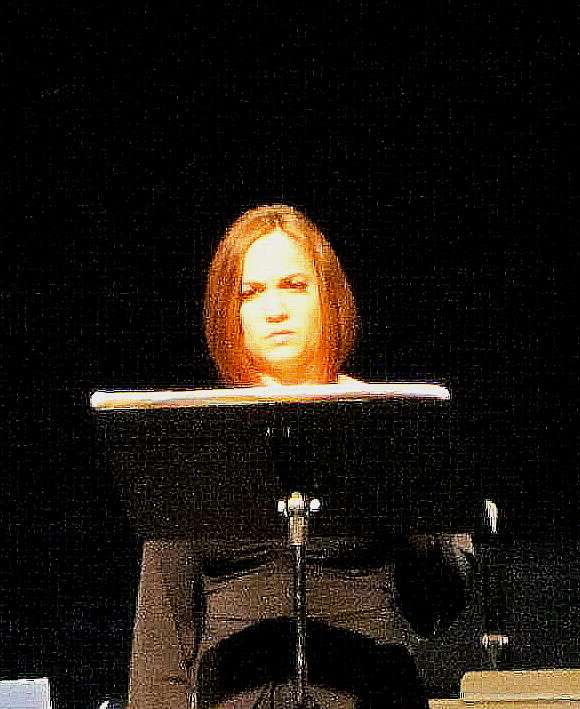|
Back
The Image and the Ideology New York
Frederick Loewe Theatre, 35 West 4th Street
02/27/2012 - Frederick Loewe Theatre, 35 West 4th Street Frederick LoweTheatre, 35 West 4th Street
NYU Interactive Arts Performance Series
Luigi Nono: La fabbrica illuminata – Ricorda cossa ti hanno fatto in Auschwitz – ...sofferte onde serene... – Con Luigi Dallapiccola
Stacy Mastrian (Soprano), Alvise Vidolin (Technical Director), Stefan Litwin (Piano), Maurizio Pollini (taped piano), NYU Percussion Ensemble: Chu Wing In, Andrew Kendris, Yael Litwin, Jeremy Lowe, Matthew Overbay, Jamie Pittie
David Fein (Conductor)
Jonathan Haas (Director), Alvise Vidolin (Artistic Director/Electronics), Thomas Beyer (Technical Director)

L. Nono (© Grazia Lissi)
The happy revelation from this, the second of three concerts devoted to the great Italian composer Luigi Nono, is that he is no Boulez, no Stockhausen. In a way–with certain premises–the accessibility of all four works on this program was immediate, emotional and at times even touching.
Frankly, I don’t joyfully attend a Boulez concert. Rightly or wrongly, I feel like I should come equipped with protractor, graph paper and tables of formulae, equations and the arcana of advanced physicists. Good ears are optional.
But Luigi Nono was, above all, both a musician and an ideologue. From his earliest years, he was a member of the Italian Communist Party. And even when he was disillusioned, his utter humanity–to the victims of Auschwitz, to the death of Federico Garcia Lorca, sympathy for the Chinese Communist Party, and Chilean workers–was foremost in his mind.
True, his music would not have energized any left-wing rally, He was no Kurt Weill, not even a Hanns Eisler. Nor were his homages to workers even relegated to quotes and direct allusions. That, obviously, would have been too bourgeois for Mr. Nono.
But at the Frederick Loewe Theatre, with its masses of percussion on stage, with loudspeakers undreamt of in Nono’s time (he died in 1990), three nights are being dedicated to a composer who, with careful listening, is remarkably and viscerally emotional.
One need not be familiar with the Second Viennese School (or any school) to hear the screams of torment in his Ricorda cossa ti hanno fatto in Auschwitz (“Remember what they did to you in Auschwitz”). No players were on stage–this was a “fixed media” piece. Nor was there “structure” in the work. But neither vocal sounds nor form could detract from the totally emotional music of near-tones, near-phonemes, near choral utterances, none of which came to fruition.
After all, reasoned Nono, what familiar sounds could possibly ever recreate the horror or Auschwitz? Yes, the feeling must be recorded (in both senses of the word), but neither prayers, poetry or human horror could duplicate the feeling. If anything, this work was a 15-minute utterances which Edvard Munch’s The Scream might have given. But it was totally Nono’s.

S. Mastrian (© Coco T. Dawg)
La fabbrica illuminata (“The Illuminated Factory”) was sung, uttered, spoken by Stacy Mastrian with four loudspeakers, taken from conversations, even negotiations with workers in a Genoa factory, along with poetry and vocalisms. This was worker passion, not the galvanizing energy of Rzewski, but possibly a pain coming out of strained music
The original tape probably could not have been translated form the Italian, but one thinks that Nono would have attempted that for this performance. Without the Italian, one wouldn’t have realized the sinister end of the first section–”How many MAN-MINUTES for dying?” Or the hopeful Pavese poetry sung at the end, “The mornings will be over, the anguish will be over. It will not always be so, we will find something.”
(I’m afraid that the workers did find something: Berlusconi! But let us forget that.)
...sofferte onde serene... (“suffering quiet waves”), the piano piece written originally for Maurizio Pollini, to be played with another recording of his own piano, was here played by Stefan Litwin with the original Pollini played–sometimes augmented, sometimes lengthened out–almost simultaneous.
This was not so much ideology as soundscape. Nono was a Venetian, with his heart (and house) on the sea. These were the sounds of ships and boats, unseen, barely heard, tones sttuck and forgotten, resonances contrasting with resonances. Waves of water and sound interlapping with each other. One could only think of the sounds like almost-forgotten memories, half dream, half waking. I don’t know if I might have even recognized these as seascapes were it not for the title. But knowing that, it did work.

NYU Percussion Ensemble (© Coco T. Dawg)
During the entire evening, the “elephant on the stage” were the jumbles of percussion instruments. During one long intermission (where the noisy air-conditioning was turned off, though distracting tapping was heard through the evening), I started to count the bass drums (about three), timpani, marimbas, tubular bells, tom-toms, wood blocks...and later I heard sleigh bells and countless other sounds, mainly in the high soprano range.
What I hadn’t realized was that many of the instruments were electronically amplified, adding even more color.
What did it have to do with Luigi Dallapiccola? I cheated and went to a reference where Nono said it was not an “homage” or “an expression of respect.”
Rather, it was explained, this was “an attempt to convey the manifold spaces of his musical thought...in a concretising autonomy.”
That didn’t explain too much. But one had to revel in the contrasting sounds, the tintinnabulations of the bells, and above all, the resonances–resonances which died out before each new section began.
For those who missed it, tonight will have one more Nono concert–and this Friday, a concert of Nono and Boulez by the Ensemble Sospeso at the DiMenna Centre, 450 West 37th Street. I cannot attend tonight’s concert, but Friday may renew this very new intriguing love affair with Mr. Nono
Harry Rolnick
|